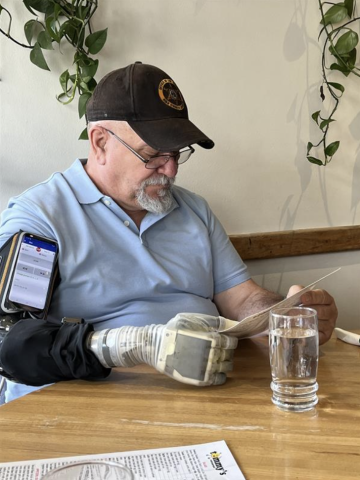Interested in neuroscience since middle school, Sedona Cady once spent a summer studying brain-computer interfaces in a non-human primate model—and she was hooked. She knew she wanted to pursue neuroprosthetics research as a graduate student.
Now a biomedical engineering Ph.D. student at Case Western Reserve University, Cady recently had the opportunity to present her research at The Pentagon in Arlington, Va., along with a study participant, Human Fusions Institute (HFI) Director Dustin Tyler, biomedical engineer Joris Lambrecht and clinical research nurse Melissa Schmitt. The Defense Advanced Research Projects Agency (DARPA), the United States Department of Defense research and development agency, invited the team to present their research. It allowed the study participant to demonstrate HFI’s iSens prosthetics system and the CWRU team to explain the scientific and engineering side of the life-changing technology.
“It seemed that many people enjoyed hearing about our research,” Cady said. “Our study participant did a great job of showing off his implanted technology.”
Tyler’s iSens project involves a fully implanted neural interface for somatosensation and myoelectric control of prostheses.
Cady said she was interested in the project since interviewing with Tyler for a PhD position in 2019.
“Attendants were very interested in (our study participant’s) experience, and they were especially wowed when he could still feel when the prosthesis was touched even without wearing it,” said Lambrecht.
“The team did such an excellent job in setting up, describing, and demonstrating the hard work and hard-won success of the iSens system,” Tyler said. “There was lots of interest, and everyone at one point or another said something like, ‘That is amazing.’”
“Seeing all the other DARPA performer’s projects on display was truly amazing,” Schmitt said. “Our demonstration was well received, and it was impactful to have a participant there to talk about the applications for prosthetics.”
While there, Cady also enjoyed seeing examples of other successful DARPA-funded projects from around the country and sharing her own research. She especially enjoyed seeing research from one group demonstrating machine-learning techniques to detect deep fake videos and from another converting defense waste materials to products like robots and autonomous vehicles.
“It was great to learn about other engineering projects outside of biomedical engineering,” she said, “which I hear about almost every day.”
Much of the time on the iSens project is spent working with individuals with upper-extremity limb loss.
“From spending so much time with these individuals, we get to know them well and understand user needs and perspectives that may have otherwise been unknown,” Cady said. “I felt most proud of this project when our study participant first used the iSens bidirectional setup; he controlled the DEKA Luke arm with three degrees of freedom while feeling sensations on several of his fingers and palm. This milestone took a lot of time and work to achieve.”
Cady also has appreciated learning about the development of implantable technologies and the steps that go into running a randomized clinical trial.
“I love how the iSens project opens up so many questions about neuroscience, psychology, engineering, and many other disciplines,” she said. “I have learned a lot from working on this project.”
In addition to her iSens research, Cady studies several other scientific questions related to stimulated somatosensation perception, including how stimulation paradigms affect discriminability and how the somatosensory locations change over time.


